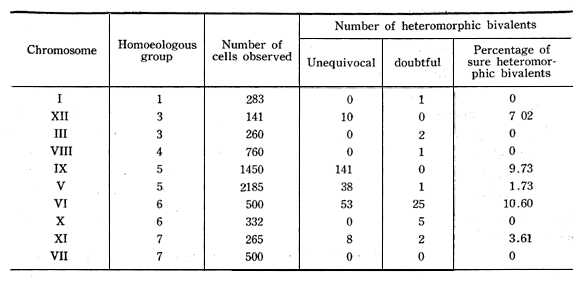Further information on identification of the chromosomes
in the A and B genomes
M. OKAMOTO
Curtis Hall, University of Missouri Columbia, Missouri, U. S. A.
Subsequent to the previous report (Okamoto, WIS No. 5) on the identification
of certain chromosomes of the A and B genomes, additional data have been
obtained, and chromosomes III, X and XII added to the list.
In crosses of the amphidiploid Triticum aegilopoides x Aegilops
squarrosa (AADD) with Chinese Spring wheat (AABBDD), in which the
F1's carried a telocentric for a particular A- or B-genome
chrormosome, heteromorphic bivalents were observed as given in the following
table.
On the basis of the differences in the frequency of heteromorphic bivalents,
chromosomes VI, IX, XI and XII are in the A genome and chromosomes I,
III, V, VII, VIII and X are in the B genome. Since it may be assumed that
homoeologous chromosomes are in different genomes, XIV and IV must be
in genome A.
The above results agree with Larson's hypothesis as concerns chromosomes
I and XIV, IV and VIII, and VI and X, but disagree for chromosomes III
and XII, V and IX, and VII and XI.
The finding that IX is in the A genome conflicts with the long-standing
assumption, for which Matsumura (1947, 1951) has presented corroborative
data, that this chromosome is in the B genome. However, although the fact
that telo-V forms a heteromorphic bivalent in low frequency is somewhat
anomalous, the present results apparently leave no escape from the conclusion
that IX is in the A genome. A possible explanation for Matsumura's results,
which involved a comparison of AABBDD x AA deficient and non-deficient
for chromosome IX, can be found in the reduced pairing caused by chromosome
V in AABBDD x AADD (Okamoto, WIS No. 5). Chromosome IX may have had a
similar effect in Matsumura's material.

Because of the discovery of Sarkar and Stebbins that the B genome most
probably came from Ae. speltoides or one of its close relatives,
there is no longer any basis for the belief, expressed by McFadden and
Sears (1946), that the free-threshing gene (Mac Key's Q) was obtained
from the B-genome ancestor; for no such gene is known in the Ae. speltoides
group. Q presumably arose as a mutation in either tetraploid or
hexaploid wheat, and may just as well have arisen on a chromosome of either
the A or B genomes.
(Received Sept. 1, 1957)